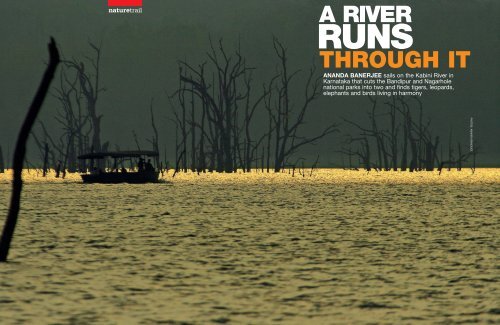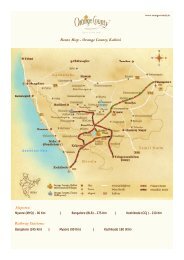Create successful ePaper yourself
Turn your PDF publications into a flip-book with our unique Google optimized e-Paper software.
naturetrail<br />
A RIVER<br />
RUNS<br />
THROUGH IT<br />
ANANDA BANERJEE sails on the Kabini River in<br />
Karnataka that cuts the Bandipur and Nagarhole<br />
national parks into two and finds tigers, leopards,<br />
elephants and birds living in harmony<br />
PHOTOS: ANANDA BANERJEE
The Kabini simmers in the orange glow of the<br />
afternoon sun as our boat cruises along,<br />
negotiating the myriad dead wooden stumps<br />
that snake above the water level. These are<br />
mostly remains of the once mighty trees<br />
submerged by the waters of the dam. As the river ripples<br />
like a melting golden dragon, birds skin over it on the way<br />
back to their roost. This is one wild country that JMW<br />
Turner would have loved to paint. And for me, it’s a neverending<br />
adventure trail that encompasses both Bandipur<br />
and Nagarhole national parks.<br />
Located southwest of Bengaluru, Kabini is a tributary<br />
of the Cauvery. Its still waters meander through the<br />
national parks separating the two. A few resorts situated<br />
along its backwaters give enthusiasts an opportunity to<br />
luxuriate in Nature’s bounty.<br />
We navigate along the shoreline, often startling the<br />
birds who lazily sit along the shores, their beaks<br />
submerged in the water as they try to spot their prey.<br />
Water birds here range from ducks, herons, storks, egrets,<br />
terns, darters and cormorants. An osprey dives at the<br />
farthest end and within seconds comes out with a fish<br />
weighing around 300 gm. It’s smooth and fast but gives<br />
me enough time to capture its fleeting glimpse in my<br />
camera.<br />
Though it has a healthy population of wildlife, the park<br />
is a destination famous for Asian elephants. Vikram<br />
Nanjappa, the chief naturalist at <strong>Orange</strong> <strong>County</strong>, who has<br />
been documenting the natural history of Kabini for a<br />
decade, tells me that the jumbo count goes higher as the<br />
water recedes during summer. The single largest<br />
congregation of elephas maximus is believed to be here.<br />
During our two-and-a-half hour boat tour, Vikram, along<br />
with his colleague Venkat, shows me at least 14 different<br />
groups numbering three to 15. We spot a family of five, led<br />
by the bull, walking in for a dip. The calves forage on the<br />
bamboo and kick at the grass to pull the roots and bulbs<br />
out of the ground. We switch off the boat engine to cut off<br />
all noise and watch silently as the matriarch leads her<br />
family to the water. After drinking and playfully spraying<br />
around, the ritualistic dust bath begins in full earnest<br />
enveloping the area with a thick hazy blanket. All this while<br />
the elders guard and surround their youngest member like<br />
a phalanx. Not for a single moment do they drop their<br />
guard and as another tourist boat drifts towards the shore,<br />
they make a hasty retreat. This area was once a favoured<br />
staging ground for the Khedda — a method of capturing<br />
wild elephants. A whole herd would be driven into a<br />
stockade by skilled mahouts mounted on tamed<br />
Clockwise from top: Little Cormorants pose on backdrop of<br />
the setting sun, Grey Heron, Wooly-necked Stork with<br />
Painted Storks, Peafowl, Western Reef Egret and India Roller
(Clockwise) Elephants near the waterfront; sambar and spotted deer<br />
elephants. The captured animals were domesticated and<br />
used for transportation and sports.<br />
Though the jumbos steal the show on the water front,<br />
there are also large congregations of spotted deer (axis<br />
axis) who come out similarly to graze along with a handful<br />
of their larger cousins, the sambar. Along with the<br />
elephants, they make a happy picture as we start looking<br />
for signs and alarm calls. This is prime tiger country as well<br />
and many a time, Vikram, Venkat and others have spotted<br />
the stripes crossing over or coming out to quench their<br />
thirst. There are some strategic points where a tigress has<br />
been sighted in recent days and Vikram takes us to a<br />
particular spot to try our luck.<br />
We harbour our boat in a small channel under the<br />
dense bamboo forest. It is comparatively dark here as only<br />
a few filtered rays of the sun manage to reach the ground.<br />
Sitting on our haunches we wait... wait and wait. Our eyes<br />
and ears are supersensitive to pick up anything, movement<br />
or sound. Could this be our day It is like several of Jim<br />
Corbett’s tales, waiting for a man-eater tigress to show up<br />
in one of the forests in Rudraprayag. The documented<br />
details of his encounter are still fresh in my mind. Luckily<br />
the one we are waiting for does not have much interest in<br />
humans. And this fact is further confirmed when she does<br />
not turn up as the sun begins to dip beyond the horizon.<br />
Vikram decides to call it a day. Even as we get into the<br />
jeep, our eyes are still trained to look between the bushes.<br />
Back at the camp, I slip into my private pool hut.<br />
Nothing sucks away the stress better than a chilled dip.<br />
For dinner, chef Lakshmi Narayana conjures up some<br />
fabulous local delicacies like Sigadi Saaru (prawn curry),<br />
Handi Saaru (pork curry), Majji Gasaare (cucumber in<br />
namaskaar 50 april 2010
The forest road at Nagarhole. (Below) The crocodile and the egret basking in the sun<br />
yogurt) and Halasande Soppina Palya<br />
(spinach) in front of a fantastic dance<br />
performance by the Kuruba tribals. A local<br />
tells me that the dance is dedicated to a<br />
good harvest, marriage and thanksgiving.<br />
Must say, with just two local instruments, a<br />
drum called daol and clarinet called karal,<br />
they put up a great show and compel us to<br />
sway to their rhythms. Before I hit the sack,<br />
the local recounts an old Kuruba saying<br />
that sums up the spirit of the people of this<br />
land. It goes: “The bear and my ancestor<br />
lived feasting on honey. The bear always<br />
left half of the honey for my ancestor. If my<br />
ancestor harvested the honey first, he left<br />
half of it for the bear. Sharing the honey<br />
thus, they lived in the forest for ages.” I was<br />
witness to this spirit of “living in harmony”<br />
when I saw a crocodile basking in the sun<br />
along with an egret earlier in the afternoon.<br />
They both enjoyed their siesta. Wonder if<br />
we city-breds can pick up a few tips from<br />
the wild. Needless to say, I sleep like a log.<br />
Vineeth, another senior naturalist,<br />
comes to pick me up for the morning safari<br />
inside Nagarhole. This time I decide to<br />
venture inside the forest. I had met Vineeth<br />
the previous evening where he showed me<br />
his photographs taken a day before. It was<br />
his best ever sighting, two leopards and<br />
one tiger in a single frame. With the<br />
photograph in my hand, my hopes soar<br />
high. This could well be my day... but being<br />
a frequent wildlife traveller, I know how one<br />
should never have any expectations on<br />
sightings and should just be one with the<br />
forest. But such stories accompanied by<br />
visual evidence induce a certain greed<br />
which overpowers you sometimes.<br />
We set off sharp at 6 am. The day<br />
begins well as Vineeth shows me a bird<br />
which I had been looking for, for a long<br />
time. The species in question is the western<br />
reef egret, a coastal bird with two different<br />
plumages, grey and white, and with yellow<br />
feet. Most surprisingly, a single bird has<br />
flown inland and made Kabini its temporary<br />
home. It is sitting on a stump on the shore<br />
line just next to the camp boundary<br />
sporting a unique morph of grey and white<br />
rarely seen and photographed. It’s a lifer, (in<br />
birding terms) a species seen for the very<br />
first time.<br />
After traversing through the village, we<br />
namaskaar 52 april 2010
naturetrail<br />
The full moon rises over the resort<br />
finally enter the main gate of the Reserve that reads “Rajiv<br />
Gandhi National Park” and soon enough find ourselves<br />
bouncing and bobbing vigorously on its bumpy tracks.<br />
Nagarhole or Rajiv Gandhi National Park is spread over a<br />
lush 640 sq km area but only a very small part of this vast<br />
jungle is open to tourists. In stark contrast to the concrete<br />
jungles that our cities are turning into, this one is an<br />
absolutely stunner. Tall trees, isolated jungle ponds,<br />
suddenly appearing and then disappearing backwaters,<br />
rustling leaves and creaking branches, cooing birds and<br />
animal calls, along with the brilliant rays of the sun lighting<br />
the forest, after getting filtered through the dense foliage,<br />
give it a pristine touch.<br />
First we cross the water body to the Nagarhole side,<br />
entering the park perimeter through the Sunkadakatte. By<br />
seven, Vineeth and I reach the exact location where a<br />
couple of days back the great drama had unfolded.<br />
Expectedly, the spot wears a desolate look with the red<br />
dirt road cutting through the dry and moist deciduous<br />
forest. An Indian roller is perched on a bare tree bark, with<br />
eyes focussed on its prey. It graciously flies down, flapping<br />
its wings to gain speed and sways away with an insect.<br />
More elephants cross our path but there are no alarm calls<br />
and the forest remains silent. The peacefully grazing deer<br />
and the playful Hanuman langurs are indication enough<br />
that there has been no predator movement lately.<br />
But who knows<br />
We continue our vigil because if and when the big<br />
beast comes, we will not have time to react. We<br />
barely go 200 metres ahead when Vineeth gets excited<br />
and asks the driver to stop. He has spotted a leopard. It is<br />
sitting a few hundred metres away from us, unseen to the<br />
untrained eye. It is his tail that gives him away. We crane<br />
our necks to look between the tree trunks but still cannot<br />
see his full figure. The moment we turn our heads,<br />
we miss him. It takes another 30 seconds of<br />
concentration to figure out where he is seated. Just then<br />
the deadly cat rises, probably annoyed at being disturbed<br />
from its siesta. Our driver slowly reverses the jeep to avoid<br />
distracting the cat. It walks right in front of us. Stretches<br />
out, yawns, displaying its sharp carnivorous jaws and<br />
walks towards the pond to quench its thirst. This is<br />
instant gratification. But we are not surprised. For this<br />
what Kabini stands for.<br />
o<br />
Air India has daily flights to Bengaluru<br />
from all metros.<br />
By Rail: The nearest railhead is<br />
Nanjangud, 55 km away followed by the Mysore station at a distance of<br />
80 km.<br />
By Road: It takes about five to six hours drive from Bengaluru via<br />
Mysore to Kabini.<br />
Where to stay: <strong>Orange</strong> <strong>County</strong>. Tel: +91 (0)80 4191 1100 / 70 / 71<br />
www.orangecounty.in<br />
namaskaar 54 april 2010






